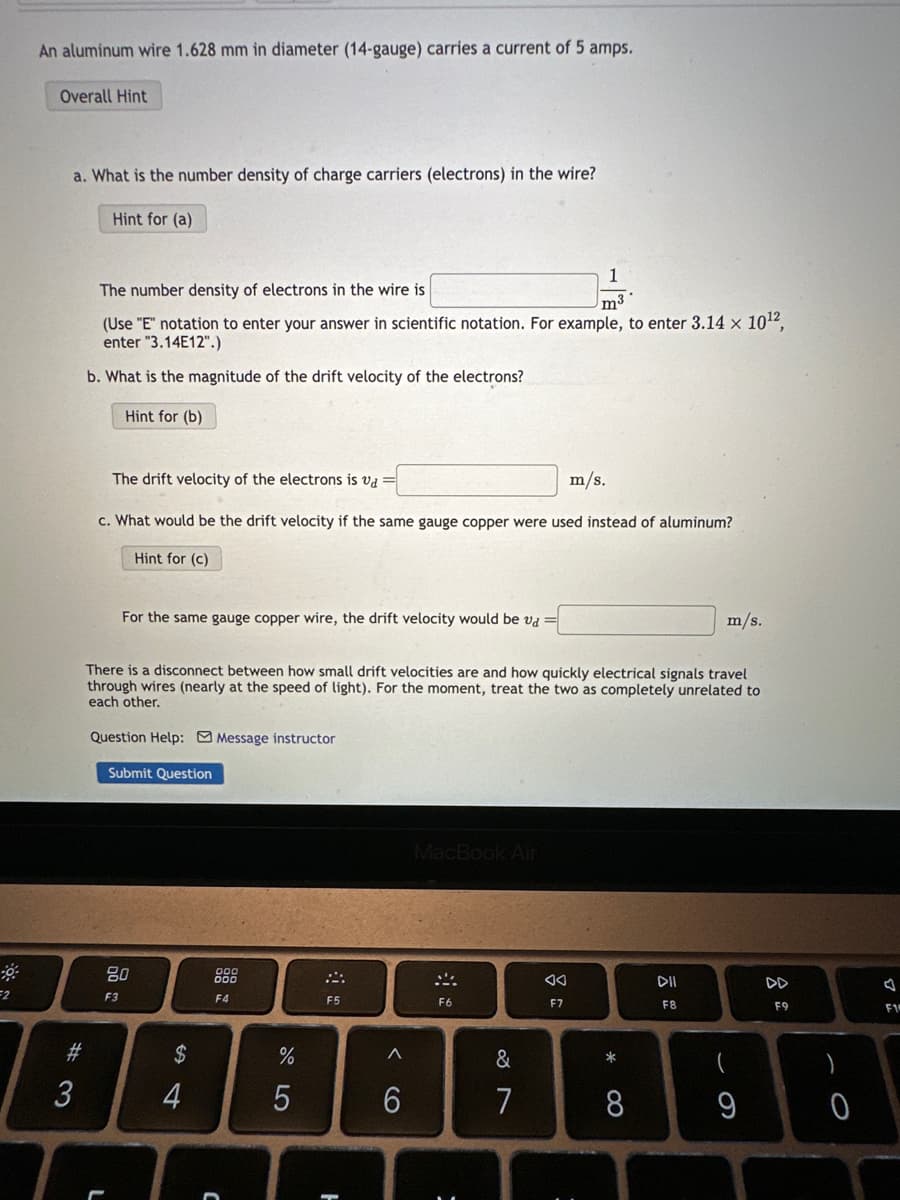An aluminum wire 1.628 mm in diameter (14-gauge) carries a current of 5 amps. Overall Hint a. What is the number density of charge carriers (electrons) in the wire? Hint for (a) 1 m³ The number density of electrons in the wire is (Use "E" notation to enter your answer in scientific notation. For example, to enter 3.14 x 10¹², enter "3.14E12".) b. What is the magnitude of the drift velocity of the electrons? Hint for (b) The drift velocity of the electrons is vd m/s. c. What would be the drift velocity if the same gauge copper were used instead of aluminum? Hint for (c) For the same gauge copper wire, the drift velocity would be vd m/s. There is a disconnect between how small drift velocities are and how quickly electrical signals travel through wires (nearly at the speed of light). For the moment, treat the two as completely unrelated to each other.
An aluminum wire 1.628 mm in diameter (14-gauge) carries a current of 5 amps. Overall Hint a. What is the number density of charge carriers (electrons) in the wire? Hint for (a) 1 m³ The number density of electrons in the wire is (Use "E" notation to enter your answer in scientific notation. For example, to enter 3.14 x 10¹², enter "3.14E12".) b. What is the magnitude of the drift velocity of the electrons? Hint for (b) The drift velocity of the electrons is vd m/s. c. What would be the drift velocity if the same gauge copper were used instead of aluminum? Hint for (c) For the same gauge copper wire, the drift velocity would be vd m/s. There is a disconnect between how small drift velocities are and how quickly electrical signals travel through wires (nearly at the speed of light). For the moment, treat the two as completely unrelated to each other.
Chapter9: Current And Resistance
Section: Chapter Questions
Problem 28P: An aluminum wire 1.628 mm in diameter (14-gauge) carries a current of 3.00 amps, (a) What is the...
Related questions
Question
100%

Transcribed Image Text:F2
An aluminum wire 1.628 mm in diameter (14-gauge) carries a current of 5 amps.
Overall Hint
a. What is the number density of charge carriers (electrons) in the wire?
# 3
3
Hint for (a)
1
The number density of electrons in the wire is
m³
(Use "E" notation to enter your answer in scientific notation. For example, to enter 3.14 × 10¹2,
enter "3.14E12".)
b. What is the magnitude of the drift velocity of the electrons?
Hint for (b)
The drift velocity of the electrons is vd =
c. What would be the drift velocity if the same gauge copper were used instead of aluminum?
Hint for (c)
For the same gauge copper wire, the drift velocity would be va
r
Question Help: Message instructor
Submit Question
There is a disconnect between how small drift velocities are and how quickly electrical signals travel
through wires (nearly at the speed of light). For the moment, treat the two as completely unrelated to
each other.
80
F3
54
$
4
F4
C
do 5
%
F5
ㅏ
< 6
6
MacBook Air
F6
=
&
7
8
AA
m/s.
F7
*
8
m/s.
DII
F8
(
C
DD
F9
0
F10
Expert Solution
This question has been solved!
Explore an expertly crafted, step-by-step solution for a thorough understanding of key concepts.
This is a popular solution!
Step 1: Given data and what is find
VIEWStep 2: Using formula for number density of electron and find its value for aluminium wire
VIEWStep 3: Using formula for drift velocity and find its value for aluminium wire
VIEWStep 4: Using formula for drift velocity and find its value for copper wire
VIEWSolution
VIEWTrending now
This is a popular solution!
Step by step
Solved in 5 steps with 5 images

Knowledge Booster
Learn more about
Need a deep-dive on the concept behind this application? Look no further. Learn more about this topic, physics and related others by exploring similar questions and additional content below.Recommended textbooks for you

